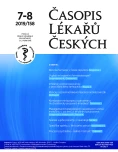Combination of mirtazapine and paroxetine: possible clinically demonstrated interaction?
Authors:
Jaroslava Červeňová
Authors‘ workplace:
Obchodně-lékárenský odbor – Klinická farmacie Lochotín, FN Plzeň
Published in:
Čas. Lék. čes. 2019; 158: 310-313
Category:
Case Report
Overview
We currently have a wide range of antidepressants available. However, the mechanisms of action are different, giving a theoretical justification for their combination in the failure of monotherapy. However, the combination of drugs entails, in addition to benefits, an increase in the risk of, for example, drug interactions. Many drug interactions in psychiatry are due to the pharmacokinetic interactions between drugs, where their plasma concentrations are altered by inhibiting or inducing cytochrome P450 isoenzymes, especially CYP2D6 and CYP3A4 and P-glycoprotein. When treating depression, we should consider the risks and benefits of combination therapy in individual patients and take measures to minimize the side effects of medicines.
The case report describes a case of a patient who reported significant depression after adding paroxetine and mirtazapine to psychiatric medication. As a theoretical cause, it discusses the possible clinically demonstrated interaction between paroxetine and mirtazapine, which has been clinically manifested by fatigue and pronounced daytime sleepiness.
Keywords:
antidepressants – depression – mirtazapine – SSRI – pharmacokinetics interactions – cytochrome – P450
Sources
- National Institute for Clinical Excellence. Clinical Guideline 90. Depression: management of depression in primary and secondary care. NICE, London, 2009.
- Depression in adults: treatment and management: NICE guideline, short version draft. NICE, London, 2017.
- Češková E. Kombinace antidepresiv v klinické praxi. Psychiatrie pro praxi 2003; 4: 154–158.
- Anttila SA, Leinonen EV. A review of the pharmacological and clinical profile of mirtazapine. CNS Drug Rev 2001; 7(3): 249–264.
- SPC Mirzaten. Dostupné na: www.sukl.cz
- Anders M., Kitzlerová E. Mirtazapin – lékový profil. Remedia 2004; 14(5): 387–397.
- Tallon D, Wiles N, Campbell J et al. Mirtazapine added to selective serotonin reuptake inhibitors for treatment-resistant depression in primary care (MIR trial): study protocol for a randomised controlled trial. Trials 2016; 17: 66.
- Blier P, Gobbi G, Turcotte J et al. Mirtazapine and paroxetine in major depression: a comparison of monotherapy versus their combination from treatment initiation. Eur Neuropsychopharmacol 2009; 19(7): 457–465.
- Debonnel G, Gobbi G, Turcotte J et al. Effects of mirtazapine, paroxetine and their combination: a double-blind study in major depression. Eur Neuropsychopharmacol 2000; 10: 252.
- Carpenter L, Yasmin S, Price L. A double-blind, placebo-controlled study of antidepressant augmentation with mirtazapine. Biol Psychiatry 2002; 51(2): 183–188.
- Delbressine LPC, Moonen MEG, Kaspersen FM et al. Pharmacokinetics and biotransformation of mirtazapine in human volunteers. Clin Drug Investig 1998: 15: 45–55.
- Dodd S, Boulton DW, Burrows GD et al. Metabolism of enantiomers of mirtazapine by recombinant human cytochrome P450 enzymes and human liver microsomes. Int J Neuropsychoph 2000; 3(Suppl. 1): S213.
- Störmer E, von Moltke LL, Shader RI, Greenblatt DJ. Metabolism of the antidepressant mirtazapine in vitro: contribution of cytochromes P-450 1A2, 2D6, and 3A4. Drug Metab Dispos 2000; 28: 1168–1175.
- Dahl M-L, Voortman G, Alm C et al. In vitro and in vivo studies on the disposition of mirtazapine in humans. Clin Drug Invest 1997; 13: 37–46.
- Timmer JC, Sitsen JMA, Delbressine LP. Clinical pharmacokinetics of mirtazapine. Clin Pharmacokinet 2000; 38: 461–474.
- Okubo M, Murayama N, Miura J et al. Effects of cytochrome P450 2D6 and 3A5 genotypes and possible coadministered medicines on the metabolic clearance of antidepressant mirtazapine in Japanese patients. Biochem Pharmacol 2015; 93(1): 104–109.
- Ruwe FJ, Smulders RA, Kleijn HJ et al. Mirtazapine and paroxetine: a drug-drug interaction study in healthy subjects. Hum Psychopharmacol 2001; 16(6): 449–459.
- Grasmäder K, Verwohlt PL, Kühn KU et al. Population pharmacokinetic analysis of mirtazapine. Eur J Clin Pharmacol 2004; 60: 473–480.
- Anders M. Paroxetin – lékový profil. Remedia 2003; 13(5): 294–301.
- van Lookeren-Campagne AM, Hartmans HLA, Ruwe FJL et al. A phase I, single center, randomized, partially double-blind, multiple dose, three-way cross-over study of the pharmacokinetic and pharmacodynamic interaction of Org 3770 (mirtazapine) and paroxetine in healthy volunteers (Study 22511, Report No. NL 0010166). Oss: N. V. Organon, 1998. Data on file.
- Hemeryck A, Belpaire FM. Selective serotonin reuptake inhibitors and cytochrome P-450 mediated drug-drug interactions: an update. Curr Drug Metab 2002; 3(1): 13–37.
- Gregorová J. Lékové interakce antidepresiv. PharmiNews 2009; 5: 13–14.
- Prokeš M, Suchopár J. Lékové interakce v psychiatrii – teorie a praxe. Psychiatrie pro praxi 2015; 16(2): 51–55.
Labels
Addictology Allergology and clinical immunology Angiology Audiology Clinical biochemistry Dermatology & STDs Paediatric gastroenterology Paediatric surgery Paediatric cardiology Paediatric neurology Paediatric ENT Paediatric psychiatry Paediatric rheumatology Diabetology Pharmacy Vascular surgery Pain management Dental HygienistArticle was published in
Journal of Czech Physicians

Most read in this issue
- Medication treatment of singultus in palliative care
- Intrapleural alteplase therapy: what are the knowns and unknowns?
- Sleep and its disturbances in neurology
- Proton pump inhibitors from clinical pharmacist’s point of view
